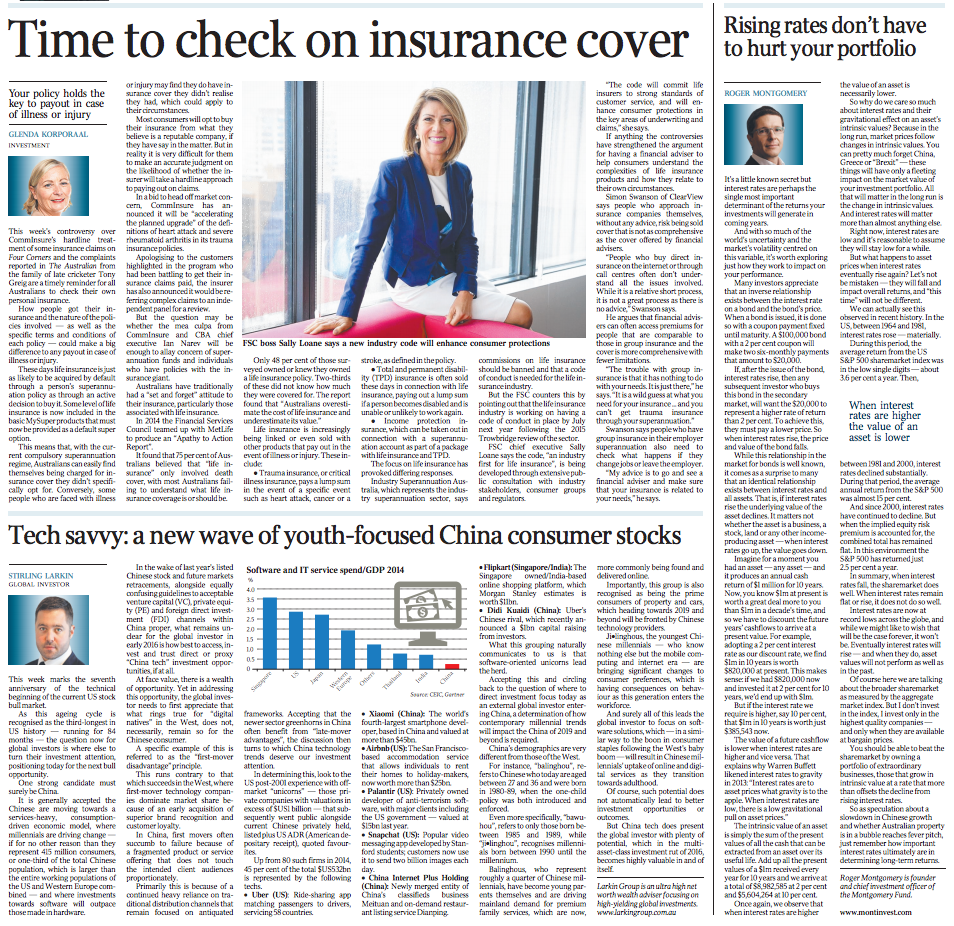Rising rates don’t have to hurt your portfolio
It’s a little known secret but interest rates are perhaps the single most important determinant of the returns your investments will generate in coming years. And with so much of the world’s uncertainty and the market’s volatility centred on this variable, it’s worth exploring just how they work to impact on your performance.
Click on the image below to read Roger’s Australian article. You can read all of the team’s press articles through browsing our media library, view more articles here.
You can read all of the team’s press articles through browsing our media library, view more articles here.
MORE BY RogerINVEST WITH MONTGOMERY

Roger Montgomery is the Founder and Chairman of Montgomery Investment Management. Roger has over three decades of experience in funds management and related activities, including equities analysis, equity and derivatives strategy, trading and stockbroking. Prior to establishing Montgomery, Roger held positions at Ord Minnett Jardine Fleming, BT (Australia) Limited and Merrill Lynch.
He is also author of best-selling investment guide-book for the stock market, Value.able – how to value the best stocks and buy them for less than they are worth.
Roger appears regularly on television and radio, and in the press, including ABC radio and TV, The Australian and Ausbiz. View upcoming media appearances.
This post was contributed by a representative of Montgomery Investment Management Pty Limited (AFSL No. 354564). The principal purpose of this post is to provide factual information and not provide financial product advice. Additionally, the information provided is not intended to provide any recommendation or opinion about any financial product. Any commentary and statements of opinion however may contain general advice only that is prepared without taking into account your personal objectives, financial circumstances or needs. Because of this, before acting on any of the information provided, you should always consider its appropriateness in light of your personal objectives, financial circumstances and needs and should consider seeking independent advice from a financial advisor if necessary before making any decisions. This post specifically excludes personal advice.
 You can read all of the team’s press articles through browsing our media library, view more articles here.
You can read all of the team’s press articles through browsing our media library, view more articles here.
2% of $100 000 is $2 000?
Good pick up Mark. If Newscorp are looking for a sub editor, I will put your name forward!
and yet the Japanese sharemarket index has doubled in the past 5yrs from about 8000 to over 16,000 ( over 18,000 in 2015 ). for better or worse, the share market can often deliver much better returns than the country’s economy may suggest. I suppose the fact that large Japanese companies such as Toyota, Canon, Sony etc earn most of their money outside Japan has some part in that, as well as zero interest keeping money in the bank. As you have often stated, there is little if any correlation between a country’s economy and it’s sharemarket returns.
Hi Roger,
Japan has low cash rate for almost 20 years, their asset has not gone through the roof. Is it because of high debt burden? Thanks
Clement
End of a long term debt cycle! Its known today as The Lost Decade (although its actually been going for more than two decades). Ray Dalio’s insightson Japan can be found here: https://www.japansociety.org/webcast/where-does-the-future-of-investments-lie-ray-dalio-on-the-japanese-world-economies
You’ll find a reasonably good summary on Wikipedia too, Here’s an excerpt: https://en.wikipedia.org/wiki/Lost_Decade_(Japan)
Japan’s strong economic growth in the second half of the 20th century ended abruptly at the start of the 1990s. In the late 1980s, abnormalities within the Japanese economic system had fueled a speculative asset price bubble of a massive scale. The bubble was caused by the excessive loan growth quotas dictated on the banks by the Japan’s central bank, Bank of Japan, through a policy mechanism known as the “window guidance”.[8][9] As economist Paul Krugman explained, “Japan’s banks lent more, with less regard for quality of the borrower, than anyone else’s. In so doing they helped inflate the bubble economy to grotesque proportions.”[10]
Trying to deflate speculation and keep inflation in check, the Bank of Japan sharply raised inter-bank lending rates in late 1989.[11] This sharp policy caused the bursting of the bubble and the Japanese stock market crashed. Equity and asset prices fell, leaving overly leveraged Japanese banks and insurance companies with books full of bad debt. The financial institutions were bailed out through capital infusions from the government, loans and cheap credit from the central bank, and the ability to postpone the recognition of losses, ultimately turning them into zombie banks. Yalman Onaran of Bloomberg News writing in Salon stated that the zombie banks were one of the reasons for the following long stagnation.[12] Additionally Michael Schuman of Time magazine noted that these banks kept injecting new funds into unprofitable “zombie firms” to keep them afloat, arguing that they were too big to fail. However, most of these companies were too debt-ridden to do much more than survive on bail-out funds. Schuman believed that Japan’s economy did not begin to recover until this practice had ended.[13]
Eventually, many of these failing firms became unsustainable, and a wave of consolidation took place, resulting in four national banks in Japan. Many Japanese firms were burdened with heavy debts, and it became very difficult to obtain credit. Many borrowers turned to sarakin (loan sharks) for loans. As of 2012, the official interest rate was 0.1%;[14] the interest rate has remained below 1% since 1994.[15]